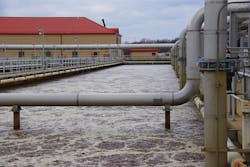By Randi Minetor
On November 4, 2016, with the presidential election just four days away, the national media did not take much notice when a water main broke in the East Falls section of Philadelphia. Local residents and shoppers got the story, however - especially those who were left stranded by rising floodwaters in a strip mall. Rescue crews in rubber rafts evacuated many shoppers as water poured into Ross, Dollar Plus, Shop Rite and other stores at Bakers Centre, a $60 million mall that had just opened in 2014.
If this were a one-time incident, it certainly would have been enough to make the mall owner and the Philadelphia Water Department want to investigate the issue. This, however, was the third water main break under Bakers Centre in two years. Thirteen million gallons of water rushed into the mall in 2014 when the first water main ruptured just before the mall opened. A second rupture in 2015 required a mass rescue operation of about 100 customers as seven million gallons inundated the parking lot and stores.
Why the recurring breaks? Four 48-inch, 120-year-old water mains run directly under the mall. Aging water infrastructure afflicts much of Philadelphia, which has one of the oldest municipal water distribution systems in the United States. Just a few days before the November 2015 Bakers Centre flood, a major main broke in West Philadelphia, drenching a neighborhood with more than 12 million gallons of water. A December 2015 break left a number of homes in Juniata Park without water service. The Germantown neighborhood experienced a break in January 2016, and in June, a water main broke in the Center City section, spilling down onto the tracks at the SEPTA train’s Suburban Station and shutting down train service.
“Philadelphia is an old city, so we manage old infrastructure,” the Philadelphia Water Department’s website informs residents. “Some of our water mains were first installed in the 1800s. PWD inspects and maintains 3,200 miles of shared water mains and relies on building owners for maintenance of their water service lines and plumbing.”
This may sound like a losing proposition, but municipalities across the country tell the same story. Water infrastructure throughout the United States is aging, and like any system that gets constant use, it is showing signs of imminent breakdown.
The crisis is so pronounced that the general public’s perception of the need for action has increased significantly in the last year. According to a survey released in 2016 by MWH Global, 68 percent of people nationwide feel that their communities should spend more money to maintain their water infrastructure. This is an increase of two percent over the 2015 survey. Forty-eight percent of people surveyed feel that not having easy, low-cost access to water is an issue in the United States.
“Major capital investment programs in water systems are happening across the United States right now,” said John Hanula, director of global business at MWH Global. “When we get involved in these capital programs, there’s always a stakeholder communication. We’ve come to a point where the customer base is actually listening. Now they get it.”
A Crisis 100 Years in the Making
Philadelphia’s recent water main issues are not isolated incidents. Water main breaks take place every day in the United States - so often that the American Society of Civil Engineers estimates that more than 240,000 breaks occur every year. Cities including Los Angeles, Washington, D.C., New York City and Boston have all experienced major failures in their water mains.
The choice to repair or replace comes down to money, according to “Buried No Longer: Confronting America’s Water Infrastructure Challenge,” an extensive report by the American Water Works Association (AWWA). “Investment needs for buried drinking water infrastructure total more than $1 trillion nationwide over the next 25 years, assuming pipes are replaced at the end of their service lives and systems are expanded to serve growing populations,” the report predicts. “Delaying this investment could mean either increasing rates of pipe breakage and deteriorating water service, or suboptimal use of utility funds, such as paying more to repair broken pipes than the long-term cost of replacing them.”
Inevitably, household water bills will go up. “The level of investment required to replace worn-out pipes and maintain current levels of water service … could in some cases triple household water bills,” the report notes.
Raising ratepayers’ costs presents one of the greatest challenges to replacing infrastructure, said Hanula. “People are willing to pay hundreds of dollars for television and premium services, but if we want to raise the water bill by ten or twenty dollars a month, we get a line of protesters. That’s why there’s a real effort by utilities to communicate their stewardship and what it takes to bring clean water to homes and businesses.”
Infrastructure Investment on the Rise
Research suggests that water and wastewater utilities are ready to take on the challenge of updating their infrastructure. “US Municipal Water Infrastructure: Utility Strategies and CAPEX Forecasts 2016-2015,” a new report by industry analysis firm Bluefield Research, says that capital expenditures (CAPEX) for U.S. municipal water and wastewater utilities should exceed $532 billion between 2016 and 2025 - a 28 percent increase over the last ten years. This forecast comes from an analysis of planned utility budgets.
“Our research indicates that the water utility sector has finally emerged from the economic downturn, which undercut public spending in water infrastructure by almost 15 percent from 2009 to 2014,” said Reese Tisdale, Bluefield president. “We anticipate a surge of network upgrades to address aging infrastructure, scaling populations, and tightening environmental regulations nationwide that will usher in new infrastructure technology and financing solutions.”
More than half of the money will be spent on pipes, the report indicates - nearly double the investment of the previous decade. “Staying ahead of 1.6 million miles of rapidly aging underground water and wastewater pipe networks poses the single largest financial challenge facing the nation’s municipal water utilities,” Bluefield stated in a summary of its findings. Another 29 percent will be invested in improvements in physical plants.
Where is the money coming from? Probably not from the federal government, which has cut funding for water utilities from $16 billion in 1976 to $4.3 billion in 2014. States and municipalities are working to shoulder the financial burden. “All of this spend is not expected to cover the full cost to catch up to an aging system, particularly if the federal government is not going to step in,” said Tisdale. That’s why “public-private partnerships will begin to take on greater significance,” he added. “They enable deployment of more advanced solutions in an industry that does not lack technology options, but rather capital.”
Teaming Up in the Hudson Valley
Just such a partnership came together in the Hudson River Valley in November 2016. Union officials, construction executives, state lawmakers, municipal executives and conservationists met to discuss the clean water infrastructure projects waiting for execution in Westchester County, just north of New York City.
The unlikely bedfellows plan to present a united front to Governor Andrew Cuomo and the New York State legislature, with the goal of receiving an $800 million allocation for water infrastructure improvements in the state’s 2017-2018 budget. A report by the Construction Industry Council of Westchester and Hudson Valley and the Construction Advancement Institute of Westchester and Mid-Hudson Inc. identified nearly $1 billion in projects to protect drinking water and control pollution in the area.
The projects include upgrades to wastewater and drinking water facilities, underground pipe infrastructure, and “culverts that are currently crumbling beneath our feet,” said Nancy Seligson, supervisor of the Town of Mamaroneck. “We need to repair our water infrastructure, and the costs are so high we can’t do it alone.”
Group efforts like this one are springing up across the country in an effort to work across partisan lines to increase funding for water improvements. The Montana Infrastructure Coalition, an association of more than 70 private and public organizations, is working to increase state funding for infrastructure replacement costs estimated between $12 and $15 billion. The Montana chapter of the American Society of Civil Engineers (ASCE), a member of this coalition, estimates that communities across the state currently invest about $165 million annually in water and wastewater infrastructure. “At this rate of investment, it will take 90 years to replace our aging water infrastructure,” noted the Montana ASCE in a statement.
Perhaps the largest and most nationally visible coalition formed in Flint, Mich., when groups representing utilities, public health, civil rights, social justice, faith and labor came together to ask Congress to provide federal aid to repair the dangerously corroded water system there. The call for funding came after the 2015 debacle in which an emergency manager for Flint changed the city’s water source to the Flint River to save money. The caustic river water corroded the aging pipes, resulting in lead leeching into the drinking water.
“It has been nearly a year since the water crisis in Flint became national news, and the tap water is still not drinkable without a properly installed filter,” said Harold Harrington, business manager of Flint’s UA Local Union 370. “It is critical that the Senate swiftly pass the Water Resources Development Act. Doing so will provide some of the funds necessary to deal with this crisis and to start to address the much needed improvement of our water infrastructure. We have waited long enough.”
Subsequently, the Water Infrastructure Improvements for the Nation Act (WIIN), containing funding for Flint’s water projects, passed both houses of Congress and was signed by President Barack Obama on December 16, 2016.
About the Author: Randi Minetor is a freelance writer and author based in upstate New York.




